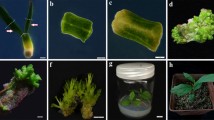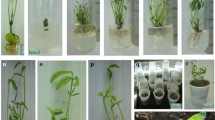Abstract
An efficient protocol has been developed for direct shoot organogenesis from embryo axes derived from mature seeds of two different landraces of Bambara groundnut. Multiple shoots were initiated on several media containing different concentrations and combinations of benzylaminopurine (BAP) or thidiazuron (TDZ). Efficient regeneration occurred when the embryo axes were first plated for 6 days on a medium containing high concentrations of BAP (1 mg/l) and α-naphthaleneacetic acid (NAA, 1 mg/l) and then cut transversely and transferred onto a medium containing 1.5 mg/l BAP. Shoot regeneration frequency was 100% and from five to eight shoots per explant were obtained. The importance of using embryo explants and cytokinins in the culture media, with respect to controlling the development of a highly organogenic system, was demonstrated. Histological studies revealed that proliferating buds originated directly from the superficial layers of the explants without an intermediate callus phase. The regenerated shoots were rooted on a medium containing 1 mg/l NAA and then transferred to the greenhouse. Flow cytometric analyses and chloroplast counts of guard cells suggested that the regenerants were diploid. All were morphologically normal and fertile. The short duration, high efficiency and low frequency of somaclonal variation of this system make it well suited for wider biotechnological applications of Bambara groundnut—a neglected and under-utilized crop.


Similar content being viewed by others
Abbreviations
- BAP :
-
N6-Benzylaminopurine
- 2,4-D :
-
2,4-Dichlorophenoxyacetic acid
- IAA :
-
Indole-3-acetic acid
- NAA :
-
α-Naphthaleneacetic acid
- TDZ :
-
Thidiazuron
- TIBA:
-
2,3,5-Triiodobenzoicacid
References
Ajayi FA, Lale NE (2000) Susceptibility of unprotected seeds and seeds of local bambara groundnut cultivars protected with insecticidal essential oils to infestation by Callosobruchus masculatus (F.) (Coleoptera: Bruchidae). J Stored Product Res 37:47–62
Akasaka Y, Daimon H, Mii M (2000) Improved plant regeneration from cultured leaf segments in peanut (Arachis hypogaea L.) by limited exposure to thidiazuron. Plant Sci 156:169–175
Binns AN (1994) Cytokinin accumulation and action: biochemical, genetic, and molecular approaches. Annu Rev Plant Physiol Plant Mol Biol l45:173–196
Brown SC, Devaux P, Marie D, Bergounioux C, Petit, PX (1991) Cytometrie de flux: application à l'analyse de la ploidie chez les végétaux. Biofutur 105:2–16
Collinson ST, Clawson EJ, Azam-Ali SN, Black CR (1997) Effects of soil moisture deficits on the water relations of bambara groundnut (Vigna subterranea L. Verdc.). J Exp Bot 48:877–884
Detrez C, Sangwan, RS, Sangwan-Norreel BS (1989) Phenotypic and karyotypic status of Beta vulgaris plants regenerated from direct organogenesis in petiole culture. Theor Appl Genet 77:462–468
Gaspar T, Kevers C, Penel C, Greppin H, Reid DM, Thorpe TA (1996) Plant hormones and plant growth regulators in plant tissue culture. In Vitro Cell Dev Biol 32:272–289
Gill R, Saxena PK (1992) Direct somatic embryogenesis and regeneration of plants from seedlings explants of peanut (Arachis hypogaea): promotive role of thidiazuron. Can J Bot 70:1186–1192
Goli AE (1995) Bibliographical review. In: Heller J, Begeman F, Mushonga J (eds) Bambara groundnut Vigna subterranea (L.) Verdc. Proc Workshop Conserv Improve Bambara Groundnut [Vigna subterranea (L.) Verdc.]. Harare, Zimbabwe, pp 4–10
Gueye M, James EK, Kierans M, Sprent JL (1998) The development and structure of root nodules on bambara groundnut [Voandzeia (Vigna) subterranea]. W J Microbiol Biotechnol 14:177–184
Gwekwerere Y (1995) Pests and disease of bambara groundnut in Zimbabwe. In: Heller J, Begeman F, Mushonga J (eds) Bambara groundnut Vigna subterranea (L.) Verdc. Proc Workshop Conserv Improve Bambara Groundnut [Vigna subterranea (L.) Verdc.]. Harare, Zimbabwe, pp 4–10
Heller F, Begemann F, Mushonga J (1997) Bambara groundnut Vigna subterranean (L) Verdc.: promoting the conservation and use of under-utilized and neglected crops, vol 9. IPGRI, Rome/Gatersleben, pp 165
Malik KA, Saxena PK (1992) Regeneration in Phaseolus vulgaris L.: high frequency induction of direct shoot formation in intact seedlings by N-6-benzylaminopurine and thidiazuron. Planta 186:384–389
Murashige T, Skoog F (1962) A revised medium for rapid growth and bioasssays with tobacco tissue cultures. Physiol Plant 15:473–497
Nitsch JP, Nitsch C (1965) Néoformation de fleurs in vitro chez une espèce de jours courts Plumbago indica L. Ann Physiol Veg 7:251–258
Ochatt SJ, Pontecaille C, Rancillac M (2000) The growth regulators used for bud regeneration and shoot rooting affect the competence for flowering and seed set in regenerated plants of protein peas. In vitro Cell Dev Biol Plants 36:188–193
Ochatt SJ, Sangwan RS, Marget P, Assoumou Ndong Y, Rancillac M, Perney P (2002) New approaches towards the shortening of generation cycles for faster breeding of protein legumes. Plant Breed 121:436–440
Odumodu CU (1992) Antinutrients content of some locally available legumes and cereals in Nigeria. Trop Geogr Med 44:260–263
Popiers D, Flandre F, Sangwan-Norreel BS (1997) Intensification de la régénération du pois (Pisum sativum L.), par le thidiazuron, via la formation de structures caulinaires organogènes. Can J Bot 75:492–500
Sangwan RS, Bourgeois Y, Brown S, Vasseur G, Sangwan-Norreel BS (1992) Characterization of competent cells and early events of Agrobacterium-mediated genetic transformation in Arabidopsis thaliana. Planta 188:439–456
Tétu T, Sangwan RS, Sangwan-Norreel BS (1990) Direct somatic embryogenesis and organogenesis in cultured immature zygotic embryos of Pisum sativum L. J Plant Physiol 137:102–109
Acknowledgements
We wish to thank Dr. P. Devaux for his valuable assistance with the flow cytometric analyses and Dr. S. Ochatt for critical reading of this manuscript. This work is part of a FAO/IAEA Coordinated Research Programme "Genetic improvement of under-utilised and neglected crops in LIFDCs through irradiation and related techniques" (1998–2003). We are grateful to Dr. K. Nichterlein of FAO/IAEA Division, Vienna for helpful discussions. Seeds of two different landraces of Bambara groundnut were provided by Dr. H.K. Adu-Dapaah (Crop Research Institute, Kumasi, Ghana).
Author information
Authors and Affiliations
Corresponding author
Additional information
Communicated by M.R. Davey
Rights and permissions
About this article
Cite this article
Lacroix, B., Assoumou, Y. & Sangwan, R.S. Efficient in vitro direct shoot organogenesis and regeneration of fertile plants from embryo explants of Bambara groundnut (Vigna subterranea L. Verdc.). Plant Cell Rep 21, 1153–1158 (2003). https://doi.org/10.1007/s00299-003-0647-0
Received:
Revised:
Accepted:
Published:
Issue Date:
DOI: https://doi.org/10.1007/s00299-003-0647-0




